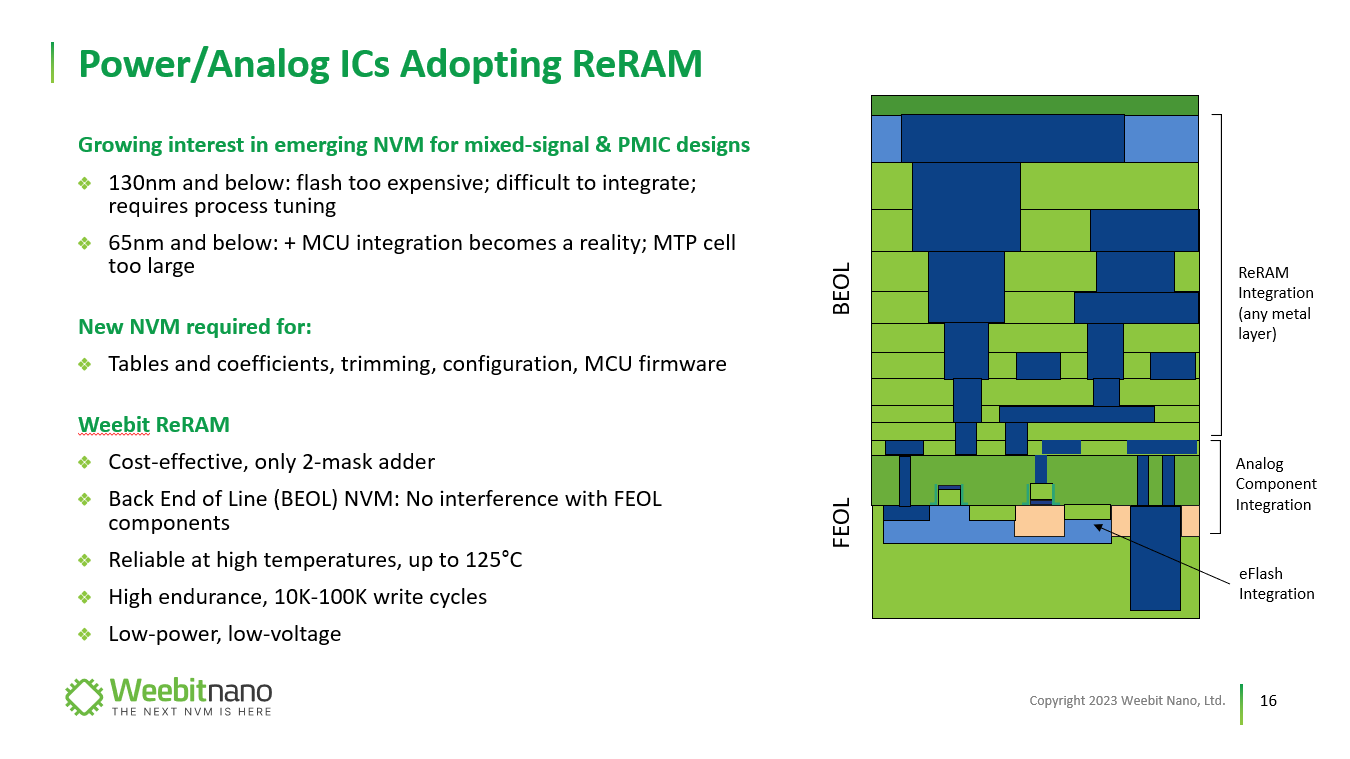Weebit Nano, a leading developer of advanced memory technologies, recently announced a significant collaboration with DB HiTek, one of the top ten foundries of the world. The collaboration is designed to enable integration of Weebit’s Resistive Random-Access Memory (ReRAM) into DB HiTek’s 130nm Bipolar-CMOS-DMOS (BCD) process. It marks a significant milestone in semiconductors for analog, mixed-signal and power designs, setting the stage for a higher levels of system integration and more competitive solutions.
Monolithic Integration and Streamlined Design
A key highlight of this announcement is the goal of monolithic integration, allowing analog, digital, and power components to coexist on the same chip seamlessly. This consolidation not only simplifies the design process but also enhances overall system performance. The synergy between ReRAM and BCD technology enables the creation of highly integrated circuits, reducing the complexity associated with external components and multiple dies.
Market Adoption and Industry Implications
The adoption of Weebit ReRAM by DB HiTek could be an early indicator of widespread industry adoption in the future. This collaboration establishes a precedent for other foundries and semiconductor manufacturers to explore the integration of Weebit ReRAM in their processes, further accelerating the industry’s trajectory towards advanced semiconductor solutions.
Versatility and Application Diversity
The announcement underscores the versatility of ReRAM, positioning it as a solution across diverse applications. From consumer electronics to industrial systems and Internet of Things (IoT) devices, ReRAM’s adaptability makes it a go-to memory technology for emerging technologies and next-generation electronic devices. This versatility opens up new possibilities for innovation and customization across various industries.
ReRAM is BEOL technology
ReRAM, as a BEOL technology, integrates in the later stages of semiconductor manufacturing. This simplifies the integration process, avoiding interference with Front-End components and allowing for straightforward incorporation into existing BCD processes. The simple stack design of ReRAM facilitates its seamless integration in the BEOL. This simplicity allows for the addition of ReRAM to existing layers of metal and insulating materials without extensive modifications.
ReRAM Advantages Over Flash Memory
ReRAM’s ease of integration, combined with high endurance, reliability at high temperatures, and low-power characteristics, positions it as an advantageous choice over Flash memory in BCD processes. The simplified integration process and reduced need for process tuning enhance the overall efficiency and performance of semiconductor designs.
Benefits to the Semiconductor Industry
The integration of ReRAM in DB HiTek’s BCD process brings forth several key benefits for the semiconductor ecosystem.
Cost-Effective Manufacturing: Weebit’s ReRAM technology requires only 2 added masks in the manufacturing process, compared to more than 10 such masks for flash. This has a direct effect on manufacturing cost and cycle time. In addition, the monolithic integration reduces the need for external components, streamlining manufacturing and lowering production costs. This cost-effectiveness aligns with industry demands for efficient and economical solutions.
Enhanced System Integration: ReRAM’s integration in the BCD process enables the seamless coexistence of analog, digital, and power components on a single chip. This not only simplifies the design process but also contributes to more compact and efficient electronic systems.
Energy Efficiency: Leveraging ReRAM’s low-power characteristics in conjunction with the power management capabilities of the BCD process enhances overall energy efficiency. This is particularly crucial in mobile applications where power consumption is a critical consideration.
Versatility and Customization: The collaboration empowers semiconductor designers with the flexibility to customize integrated circuits based on specific application requirements. The adaptability of ReRAM ensures that the technology can be tailored to meet the diverse needs of different industries.
Applications and Future Potential
The integration of ReRAM in the BCD process holds immense promise for various applications. Consumer devices like smartphones, tablets, and wearables stand to benefit from the enhanced energy efficiency and space-saving attributes of ReRAM in BCD processes. ReRAM’s robustness at high temperatures and integration with BCD’s power management make it well-suited for industrial control systems, automation, and robotics. IoT devices, with their compact size and low power requirements, could significantly benefit from the integration of ReRAM in the BCD process. ReRAM integration into BCD process also offers a powerful and efficient memory solution for the growing landscape of IoT applications.
Summary
By licensing Weebit’s ReRAM for integration in DB HiTek’s BCD process, the two companies are pioneering a path to more efficient, cost-effective, and versatile semiconductor designs. The benefits of cost-effective manufacturing, enhanced system integration, energy efficiency, and application versatility position ReRAM in BCD as a transformative solution for the semiconductor industry. As the integration gains momentum, we can anticipate a wave of innovation across various applications, ultimately shaping the future of semiconductor design.

You can access the Weebit Nano – DB HiTek joint press release here.
For more details about Weebit’s technology and solution offerings, visit www.weebit-nano.com
Also Read:
A preview of Weebit Nano at DAC – with commentary from ChatGPT
Weebit ReRAM: NVM that’s better for the planet
How an Embedded Non-Volatile Memory Can Be a Differentiator
Share this post via:




Comments
3 Replies to “ReRAM Integration in BCD Process Revolutionizes Power Management Semiconductor Design”
You must register or log in to view/post comments.